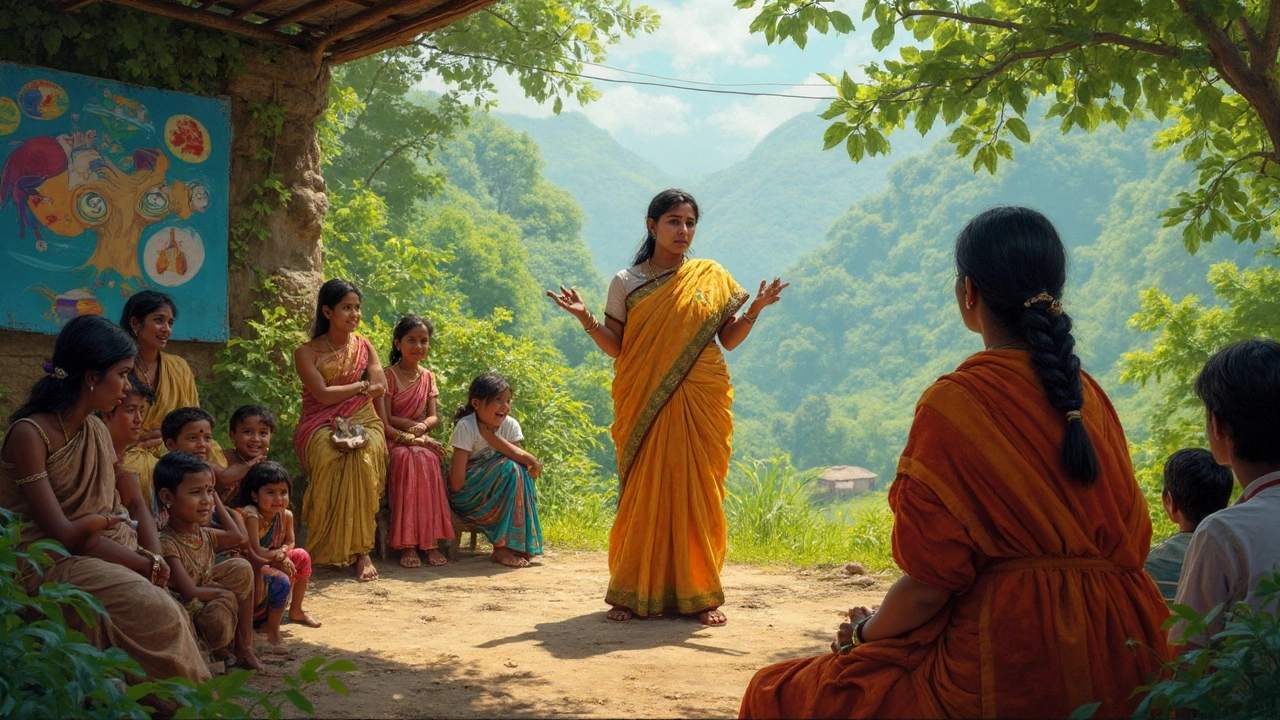Ever wonder what community outreach programs really aim to achieve? It's a lot more than just hosting events and volunteer drives. At the heart of these programs is the goal of strengthening a community by addressing specific needs and creating connections among people.
First off, community outreach is all about identifying what matters to local folks. Whether it's improving education, healthcare, or housing, the aim is to make a real impact where it's needed most. And to do this, understanding the unique challenges and opportunities within the community is key.
- The Core Goals of Outreach
- Community Needs Assessment
- Benefiting All Participants
- Building Long-Term Relationships
- How to Get Involved
The Core Goals of Outreach
So what exactly are the primary aims of a community outreach program? At its core, it's about making life better for everyone involved—both the community members and those running the program. But it doesn't stop there!
Improving Access to Resources
A huge goal of such programs is to ensure people have access to the necessities they might be missing. For instance, are kids in need of tutoring? Or perhaps there's a gap in healthcare services? Programs aim to bridge these gaps, improving lives through increased access and support.
Fostering Engagement and Relationships
An often-underestimated aim is to create a sense of belonging and unity. By bringing people together to work on common goals, community outreach has the power to build lasting relationships. These bonds not only boost morale but also encourage ongoing community involvement.
Empowering Communities
Another essential aim is to empower people to take charge of their lives. When folks are given the tools, knowledge, and support they need, they're more likely to contribute positively to their communities and advocate for change. Simply put, it's about amplifying voices that might otherwise go unheard.
Enhancing Skills and Education
Skills development is a huge focus too. Many programs offer workshops, courses, or mentorship opportunities to hone important skills, from financial literacy to digital proficiency. Participants gain personal growth while making the community at large more skilled and competitive.
Measuring Success
Okay, so how do you know if these programs actually work? Metrics can vary, but common ones include participant numbers, resource allocation, and overall community satisfaction. Some programs even track specific outcomes like improved school grades or reduced crime rates to highlight their impact.
Community Needs Assessment
Diving into a community needs assessment isn't just about filling out a survey; it’s an essential process for making community outreach effective. So, what does this assessment involve? It’s about understanding what your community truly needs. This means looking beyond the obvious and digging into the real issues people face daily.
Why Do We Need It?
Imagine trying to solve a puzzle without seeing all the pieces. That’s what it feels like to run outreach without a needs assessment. By taking the time to actually listen to community members, we can tailor programs to their actual needs rather than what we assume they need. It's about them, not us.
Steps in a Needs Assessment
Conducting an effective assessment involves several steps:
- Identify the Community: Clearly define the community you want to help. This could be based on geography, demographics, or other factors.
- Gather Data: Collect data using surveys, interviews, and community meetings. Diverse methods ensure diverse insights.
- Analyze Findings: Dig into the data to identify common themes or pressing issues.
- Prioritize Needs: Not all needs can be met at once, so it’s essential to prioritize based on resources and potential impact.
- Share and Plan: Share your findings with the community and plan actions together. Transparency builds trust.
Real-World Benefits
Let's talk numbers. According to a 2023 study, communities that conduct thorough needs assessments see a 35% improvement in the relevance and effectiveness of their community outreach initiatives. It's a win-win: communities feel heard, and organizations deliver meaningful support.
At the end of the day, a community needs assessment isn’t just paperwork. It’s about heart and action, ensuring that the outreach truly benefits those it’s meant to serve.

Benefiting All Participants
A great thing about community outreach programs is how they create benefits for everyone involved, not just the ones receiving help. Let's break it down.
For Volunteers
If you're volunteering, you've probably noticed that it feels pretty amazing to give back. But did you know studies show volunteering can reduce stress and improve your mood? Plus, it builds up skills. Whether you're organizing events or teaching kids, you're growing in ways that enhance your resume and your personal growth.
For Community Members
Members of the community clearly gain from these projects. For them, it's about having access to resources they might not get otherwise. For instance, a community outreach program focusing on healthcare might offer free check-ups or vaccinations, improving public health. These efforts can lead to healthier, safer communities.
For the Organizations
Community outreach also benefits the organizations running these programs. They build strong ties within the community, which can lead to better support and partnerships. Imagine a small non-profit collaborating with a local business—they both gain visibility and strength. It's a win-win situation.
Shared Success
At the end of the day, everybody wins. A well-run outreach program makes communities more connected, more supportive, and often a lot happier. When everybody shares in the effort, the successes are more meaningful and sustainable.
Building Long-Term Relationships
One of the coolest things about community outreach is how it helps in creating long-lasting connections. Sure, it's great to help out in the short term, but the magic happens when relationships grow over time.
Think about it: when you consistently work with others in the community, trust builds up. This trust is crucial as it lays the foundation for effective collaboration. People are more likely to open up and work together when they feel secure and valued.
Consistent Engagement
Maintaining regular contact is key to fostering these long-term relationships. Consider setting up periodic check-ins or casual meet-ups where everyone can share updates and feedback. When folks know you're genuinely interested in their experiences and challenges, it strengthens the communal bond.
Mutual Benefits
Long-term relationships in outreach aren't just about helping others; everyone involved benefits. It's a two-way street where resources, knowledge, and support flow back and forth. Over time, these exchanges result in more resilient and empowered communities.
Success Stories
Let’s look at some success stories from around the globe. In several towns, sustained volunteer programs have led to decreased crime rates and improved local services. For example, a study from a 2022 report showed that neighborhoods with active community outreach programs saw a 15% increase in public engagement activities.
Tables of data can sometimes highlight the results of long-term efforts better than words alone, giving a clear picture of progress and impact.
| Year | Crime Reduction (%) | Public Engagement Increase (%) |
|---|---|---|
| 2021 | 5 | 10 |
| 2022 | 10 | 12 |
| 2023 | 15 | 15 |
So, if you're part of a community outreach endeavor or thinking of joining one, remember that nurturing long-term relationships is where the real change happens.

How to Get Involved
Joining a community outreach program can seem daunting at first, but it's actually pretty straightforward. Whether you have a lot of time to spare or just a couple of hours a month, there's a way you can pitch in and make a difference.
Start Local
The best place to begin is right in your own backyard. Check out local community centers, schools, or nonprofits. They're always in need of people who can contribute their time and skills. Whether it's helping at a food bank or tutoring after school, every bit helps.
Tune Into Your Network
Your friends and family might already be volunteering somewhere. Ask around to see if you can tag along. Not only will you help a cause, but you'll also likely have more fun volunteering with people you know.
Look Online
Many organizations use social media or platforms like VolunteerMatch or Idealist to post volunteer opportunities. It’s a quick way to find roles that match your interests, skills, and availability.
Be Ready To Learn
Every program has its own way of doing things. When you start, keep an open mind, ask questions, and be prepared to learn. Remember, engagement is about both giving and receiving new experiences and knowledge.
Time Commitment
Before committing, think about how much time you can realistically offer. Some programs require regular attendance, while others might be more flexible.
Unsure about how to get started? Here's a quick checklist to guide you:
- Identify causes you care about.
- Research local organizations or online platforms.
- Contact them to find out their needs and what roles they offer.
- Schedule a visit or meeting to see their work firsthand.
- Commit to a role that fits your schedule.
By getting involved in community outreach programs, you're not just helping others—you're also enhancing your own life. From building new skills to expanding your social circle, the benefits are endless. Plus, you get to be part of something bigger than yourself.
